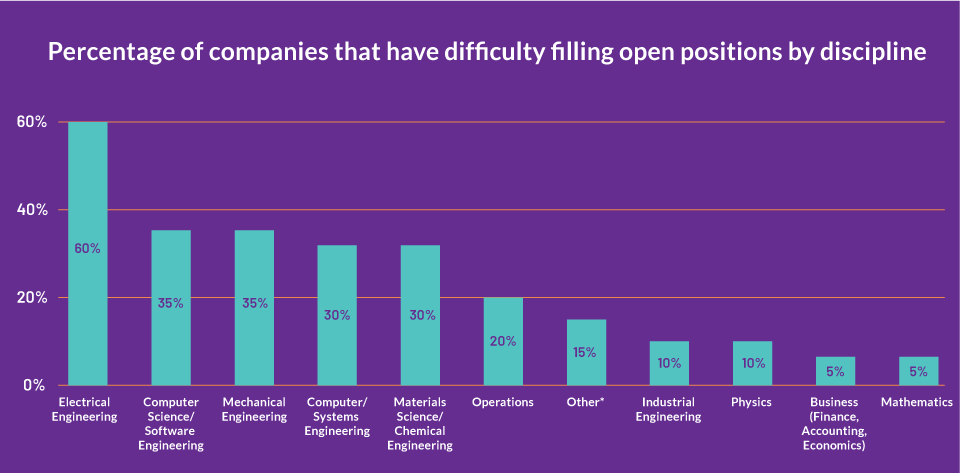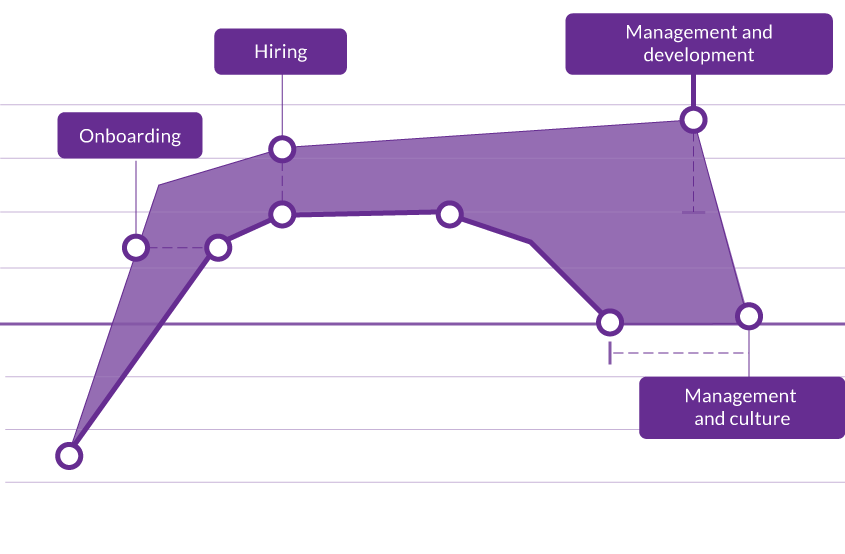Hiring tech talent for building a highly-qualified engineering team is like looking for a needle in a haystack. According to a recent survey from Deloitte, 82% of executives reported a shortage of qualified technical talent.
Among the most disputed professionals reported in this research are: computer sciences/software engineering (35%) and computer systems/engineering (30%). Not to mention the boom in demand for engineers that only tends to grow:
- Demand for AR/VR talent is up by 1400%, mirroring blockchain’s 517% demand growth last year.
- Demand for frontend and backend engineers grew steadily by 17%, which shows that all companies — not just Silicon Valley tech giants — are evolving into being tech companies.
- In large US tech hubs, AR/VR Engineer salaries range from $135k – $150k.
- While pay for most Americans has grown between 3 – 3.5%, top engineering roles in San Francisco and New York have seen salaries grow at double that rate: 6% and 7%, respectively.
- Young engineers are focused on work for companies like Facebook, Amazon, Google, and NetFlix increasing the difficulty of the recruitment process.

35% of companies have difficulties in filling software engineering positions. Source: https://hired.com/state-of-software-engineers#intro
But despite this fierce dispute for technology talent, there is an opportunity to recruit those who are not looking for work. And this is where you will find your gold.
Another survey from Stack Overflow found that almost three-fourths of developers are open to new opportunities. That statistic includes much of the 85% of developers who aren’t looking for work.
That means if you change your recruitment approach you may start to see different results. Shortly, hiring tech talent demands a high-tech recruitment plan which involves some of the strategies that we gathered below.
There’s science on how to find highly-qualified tech professionals
High tech recruitment is science. Firstly, you need to establish a clear and efficient method to plan and strategize the entire process. Secondly, it’s important to focus on your strategy, spending time to analyze what is working or not in order to quickly adapt it, if necessary.
Naturally, each company has its own objectives and goals. Anyway, the majority of them need to achieve value delivery with their products. And the point is: you only can achieve incredible results if you have a highly competent and collaborative team.
Thinking about that, your strategic plan of tech recruitment should include:
- Alignment of company’s goals and SDLC/development culture
- Map out stakeholders and timing expectations
- Asses proficiency, skills requirements, as well as the product roadmap
- Outline the hiring process: from the communication plan to the talent acquisition tactics
- Define search focus (inbound, outbound, networking, and so on)
- Running in-depth interviews and take-home tests to the tech validation step
- Set up a strategy to identify behavioral, social, and collaboration traits
- Take time enough to final approvals
- Organize and execute the offer/hire documentation: mainly the Statement of Work (SOW) and Master Services Agreement (MSA)
- Take care of onboarding: run paperwork, delve into company, product, and role
The truth is: tech recruitment is about method and time optimization. Unfortunately, most SMB companies (including SaaS) are not well prepared for it.
If you are in this situation, chances are you are going to take a long time to find a few candidates that are not 100% aligned with your company or product. So, how to be sure if you’re in the right way? Listen to the experts and of course, what candidates have to say.
Advice from recruiters and candidates
The first advice from recruiters during the process of finding highly-qualified tech professionals for software engineering teams is: you must guarantee that there is a good fit between the stakeholders (company and candidates).
When you choose only seniors chances are you are not going to have problems with technical skills, but how about culture and soft skills? It’s not simple like that, especially when your process is remote.
A good starting point is to understand the good fit concept. Shortly, it means that recruiters and software engineers agree with:
- The recruiter needs to meet the briefing of the team with whom the candidate will work in an honest and determined manner
- The candidate is in a career moment aligned to the company goal, rhythm, purpose, and culture
- The skills required and code quality for the position are completed contemplated by the candidate and proven by technical tests
- All the stakeholders must establish solid and clear communication during the recruitment laying all the cards on the table (salaries, how the distributed team works, methodologies, leadership profile, etc)
- The relationship between candidate and company must go beyond a simple project (it should be more than only a freelancer job), like a symbiosis connecting them
- The candidate should be equipped with information, resources, and tools that guarantee success and fluidity in his/her work
How to attract and engage top talent
Nothing goes forward if the recruiter fails to capture the candidate’s attention and after it, engages him/her to continue along the process which involves time and energy.
A good salary is of course one important point, but most surveys say that top talents are looking for long-term careers. They expect to find a place where it makes sense to stay longer. In other words, “Wake up happy on Mondays”.
But keeping someone motivated (day by day) is a hard task to do. According to a Linkedin study, 45% of employees who left companies cited concern over a lack of advancement opportunity.
Besides that, employees who don’t believe they can achieve their career goals with a current employer are 12X more likely to consider leaving. With new employees, the number jumps to about 30X more likely.
That’s why, if a software engineer chooses to work for more than a year for your company it’s because he/she sees a real benefit and value proposition in what you’re doing. But how do you communicate this value to someone who doesn’t know your company yet?
You can bet on the following recommendations:
- Write an attractive job description that communicates a high challenging position – well written from the title to the last line.
- Show through different ways and channels how your company culture and learning programs connect employees to their deepest professional aspirations
- Address what the company effectively does for its employees to give them the opportunities they seek, accelerate their growth, and transform their careers.
- Collect social proof (testimonials) that highlight the company culture and outstanding leadership
How to improve the interview process
Starting with writing an attractive job description until preparing the interview script, all the process must be planned in detail.
Why you should think carefully about your interview process:
- To avoid inconsistency– Lack of a consistent structure and process undermines interview fairness and accuracy in selecting the best candidates.
- To be focused on what matters– Don’t be distracted by quick judgments and general impressions. This could interfere with the quality and objectivity of assessing applicants.
- To be more efficient– Ask the right questions and use adequate evaluation techniques that will support you to make a better decision.
Job descriptions: the first gateway for screening top talents
Before the interview, candidates need to know what the position is about. Providing useful and specific details about the role, list job duties, mention products the candidate may undertake or teams they will work with are crucial to driving your conversation.
In addition, avoid using ambiguous, suspect, or clickbait titles. It’s more efficient to be specific and direct. For instance, use clear and inclusive language. “We opened three new branches recently” is more precise than “We are growing fast.”
Also, let the candidates know what your company does for employees, and you’ll attract candidates who better fit your needs. So, get the job title right and start with a short and engaging role overview. Also makes clear what does the role contributes to making people’s lives better, or solve existing business or social problems.
Interview plan: the key to capturing tech talent attention and set up culture fit
A study by Leadership IQ found that failures exhibited by new employees may result from flawed interview processes. Eighty-two percent of the 5,000 managers surveyed reported that the interviewers were too focused on other issues, too pressed for time or lacked the confidence in their interviewing abilities to pay attention to red flags.
Ask questions during the interview regarding their latest software release and present your recommendations respectfully based on their answers to display your genuine interest in the business, your ability to analyze core business needs, and understand tech-driven solutions.
Other tips are using a standardized point scale during the interview to measure candidate performance and Consider using group interviews for jobs that require strong interpersonal skills.
Also, it’s important to allow prospective employees to interview you, too. Letting candidates ask questions will give you a chance to see what’s important to them and gives them a chance to determine that they want to keep pursuing a job at your company, or to decide that it’s not the right fit for them.
At the end of the interview, ask the candidates to complete a brief survey for you. What did they like about the interview, job description, and hiring process as a whole? What would they change? This feedback will really help you improve your approach.
Tips that you need to know to Improve Your Tech Recruiting Strategy
If you’re in this journey of improving the tech recruiting process, the first thing to have in mind is: you need someone dedicated to sourcing and screening candidates.
As we already know, partners who custom-curate nearshore tech talent can spare 75% of the work and save 40-50% on cost-per-hire. This is possible because when you have someone qualified 100% focused on recruitment, chances are you’re gathering a talent pool more qualified. Besides high the bar of candidates, this person also will be responsible to make the interview happen, delivery of tests, and all necessary follow-up and deadlines.
Second, let’s face the reality in the IT market: most people who are employed still want to hear about new job opportunities. Surveys of employees find that only about 15% are not open to moving. As the economist, Harold Demsetz said when asked by a competing university if he was happy working where he was: “Make me unhappy.”
If people are interested in listening to good job offers, it’s time to change your recruitment approach, considering chasing passive candidates, even in the nearshore.
In fact, US organizations already registered an average of 38% to 48% savings in labor costs by outsourcing IT functions to Central and South America. Building a Nearshore Team is an opportunity to source software engineers and devs and run staff augmentation cheaper than in the US, improve product quality, team collaboration, and your ROI.
See more at Hire Remote: How to Build an Effective Tech Recruitment process
Why and how does Tech recruiting influence employee satisfaction?
Once you hire talent with the right skills and that is aligned with the company’s culture, you have already gone halfway to satisfying that person during their journey at the company.
Employee engagement is closely linked with team building, and engagement will automatically increase when employees are connected with their teammates.
Being on the same page means more than agreeing with the way a company is led. It probably means that we have the same view of the culture, which drives everybody to a high-performance team, creating innovative products for our clients and generating more revenue for our stakeholders. Some of the direct impacts of tech recruiting for employee satisfaction:
- Hiring tech talents right means source for Long-Term Engagement
- Hiring people with cultural alignment helps you to keep customer loyalty
- More retention is good for your employer brand and to keep the positive circle of recruitment of top talents.
Why and how does Tech recruiting influence employee productivity?
Process, goals, purpose, communication. There are a lot of points that influence productivity in a company. Software development is a type of knowledge work that comes with even more specific difficulties, as software developers deal nowadays with incredibly large and complex systems.
But there is an interesting line to define productivity. According to Charles Duhigg, “Productivity is about making certain choices in certain ways.” And thinking about the recruitment process, productivity only will be achieved if you choose the right professionals for the right role.
But, as you know, generally above-average high-qualified tech professionals for software engineering teams can be very expensive – especially in the US.
That’s why many recruiters are opting for nearshoring recruitment. Nearshoring and offshoring are two types of outsourcing where nearshoring is to delegate it to a company that is in the same or near time zone and it is intracontinental.
According to Statista, nearshore business process outsourcing already reached a revenue of 23.6$ billion.
This happens because nearshoring software development can be cheaper and also more efficient, once you expand your talent pool to reach high talent outside of the US. Furthermore, source nearshore tech talents give you different backgrounds which can be valuable because add new and creative ways to solve problems and deliver products.
But there is no doubt that the main benefit of nearshoring recruitment is the fact that the proximity of your remote team will give you more agility and facilitate communication with them.
Studies prove that the differences in the distance and time zones which can increase the costs of managing a project will be discussed. The overlap of time by different time zones has an impact on planning a meeting. Employees of both countries will have to take into account that they can only arrange meetings in a limited time span per day cause of the difference in time zone. This will also make it harder to speak with people “on-the-fly”.
The distance will also increase the costs. In general flights to intra-continental countries are more expensive than flights within the continent. Except for the higher costs of intra-continental flights they are also longer. During a flight, an employee, in most cases, cannot work as efficiently, which adds to the project costs.
Because of all these factors, nearshore tech professionals usually have a high-performance compared to offshoring pairs. According to surveys, nearshoring professions who have carefully chosen usually achieve productivity levels equivalent to that of the origination point. Research has shown us that productivity levels at offshore locations do increase over time but after several years it still isn’t near the productivity level of nearshore locations.
Why and how does Tech recruiting influence employee retention?
A report from SHRM (Society for Human Resource Management) shows that recruitment practices themselves strongly influence employee turnover. In fact, a failure to consider retention at this early stage could see you missing out on the best employees from the start.

Employee Lifecycle x Turnover. Source: https://www.greenhouse.io/blog/employee-lifetime-value-understand-roi
Once you consider nearshoring software teams your recruitment process will be focused on finding tech talents aligned to your culture and team needs, and you reduce your worries about money and time.
Then you have the opportunity to customize your recruitment process as your necessity and this is a huge advantage.
Added to this, the fact that building an excellent hire puts you in higher maximum output from the beginning and also will contribute to elevating other top performances of the company and increase Employee Lifetime Value.
Beyond recruitment, there are more factors that influence positively Employee LifeTime Value and retention such as:
- Onboarding and training: ensure that all applicants are 100% clear on expectations from day one, making it more likely that they’ll remain with your company.
- Give people flexibility: don’t micromanage teams means you trust them and give them space to work in their time.
- Paying competitive wages: if you can remove the uncertainty about salary in your company, do it. Let fewer people as possible think about leaving for low pay.
- Work-life balance: people who struggle with working need to have other activities and allowing team members to work to their own schedule (at least some of the time) is vital.
- Keep and Open Management Style: besides, give people flexibility and trust, it’s mandatory to be consistent and admit wrongdoings, seek out new opinions and feedback.
We help you custom curate your product engineering team with nearshore talent best suited to you.
When deciding where to find your IT outsourcing provider, it’s important to know the exact requirements of your project, the allocated budget, and the time frame allotted for completion.
If you’re considering work with high-performance nearshore development teams, talk to Ubiminds to find more about our strategy to bring the best result to your company!

International Marketing Leader, specialized in tech. Proud to have built marketing and business generation structures for some of the fastest-growing SaaS companies on both sides of the Atlantic (UK, DACH, Iberia, LatAm, and NorthAm). Big fan of motherhood, world music, marketing, and backpacking. A little bit nerdy too!


